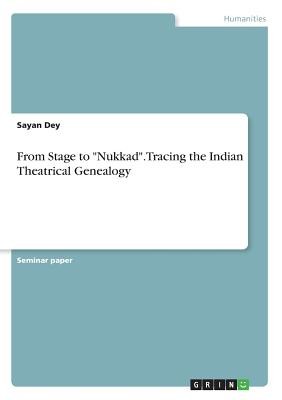
- We will send in 10–14 business days.
- Author: Sayan Dey
- Publisher: GRIN Verlag
- Year: 2016
- Pages: 36
- ISBN-10: 3668351740
- ISBN-13: 9783668351745
- Format: 14.8 x 21 x 0.2 cm, softcover
- Language: English
- SAVE -10% with code: EXTRA
From Stage to Nukkad. Tracing the Indian Theatrical Genealogy (e-book) (used book) | bookbook.eu
Reviews
Description
Seminar paper from the year 2016 in the subject Theater Studies, Dance, grade: 2, Banaras Hindu University (Department of English), course: PhD, language: English, abstract: The Theatre stage has always been a limited structure with actors and props interacting, refuting, co-existing and sometimes overlapping each other over a large milieu patiently observing them through a continuous process of association and disassociation. There was a time when theatre was narrowly limited within a handful of intellectual beings but with Diderot shattering the fourth wall, the stage moved closer to the audience. With the advent of street theatre (nukkad) the Indian theatrical scene could successfully disentangle themselves from the spatially and ideologically limited stage norms and introduce a free-flowing space for expressions. Playwrights like Safdar Hashmi and Badal Sircar actively practiced this form of theatre and often the audience became a part of enactments. This paper addresses how the stage aesthetics could be made culturally and socio-religiously relevant by transporting the stage from the high podium into the streets.
EXTRA 10 % discount with code: EXTRA
The promotion ends in 14d.20:32:16
The discount code is valid when purchasing from 10 €. Discounts do not stack.
- Author: Sayan Dey
- Publisher: GRIN Verlag
- Year: 2016
- Pages: 36
- ISBN-10: 3668351740
- ISBN-13: 9783668351745
- Format: 14.8 x 21 x 0.2 cm, softcover
- Language: English English
Seminar paper from the year 2016 in the subject Theater Studies, Dance, grade: 2, Banaras Hindu University (Department of English), course: PhD, language: English, abstract: The Theatre stage has always been a limited structure with actors and props interacting, refuting, co-existing and sometimes overlapping each other over a large milieu patiently observing them through a continuous process of association and disassociation. There was a time when theatre was narrowly limited within a handful of intellectual beings but with Diderot shattering the fourth wall, the stage moved closer to the audience. With the advent of street theatre (nukkad) the Indian theatrical scene could successfully disentangle themselves from the spatially and ideologically limited stage norms and introduce a free-flowing space for expressions. Playwrights like Safdar Hashmi and Badal Sircar actively practiced this form of theatre and often the audience became a part of enactments. This paper addresses how the stage aesthetics could be made culturally and socio-religiously relevant by transporting the stage from the high podium into the streets.


Reviews